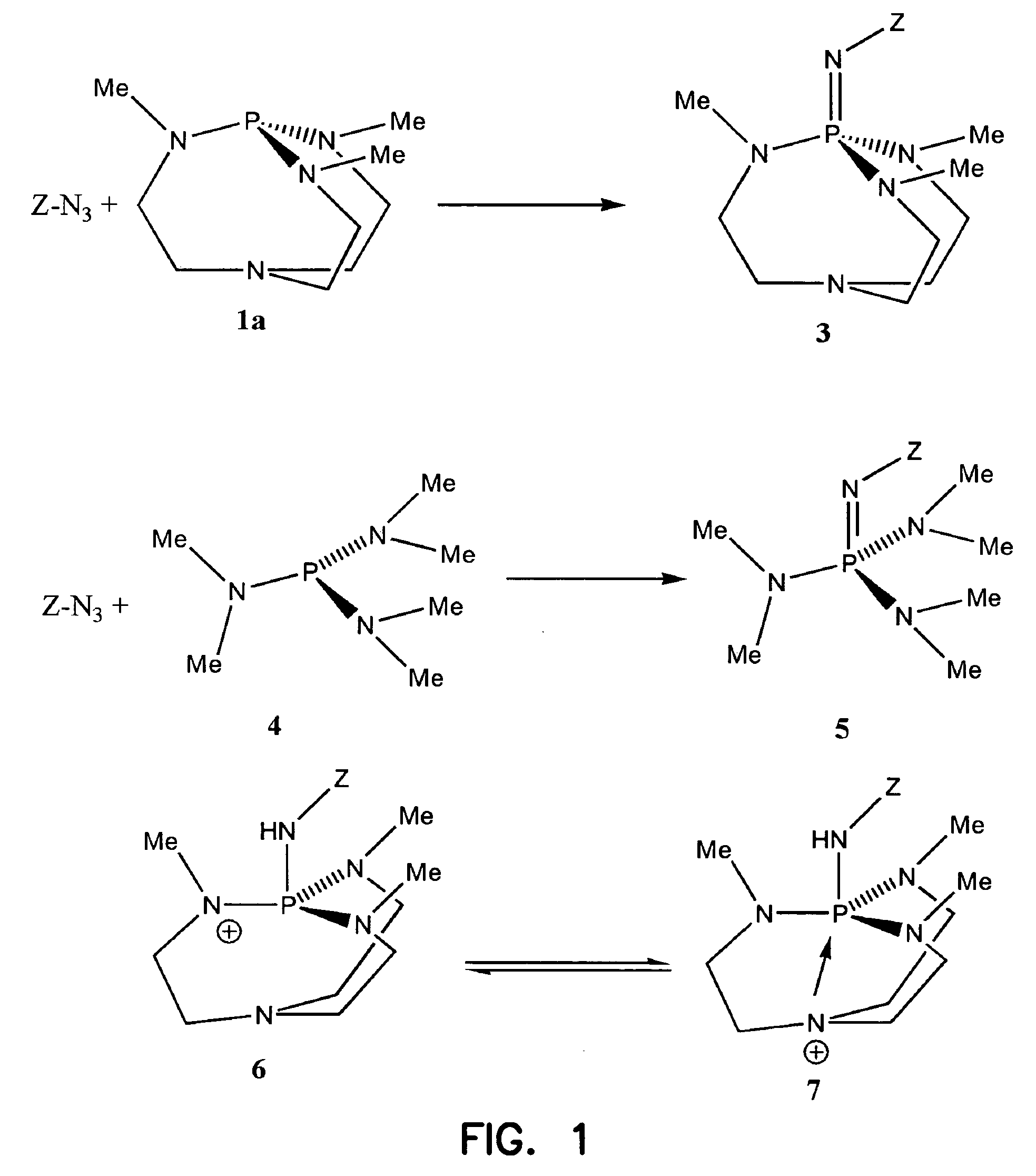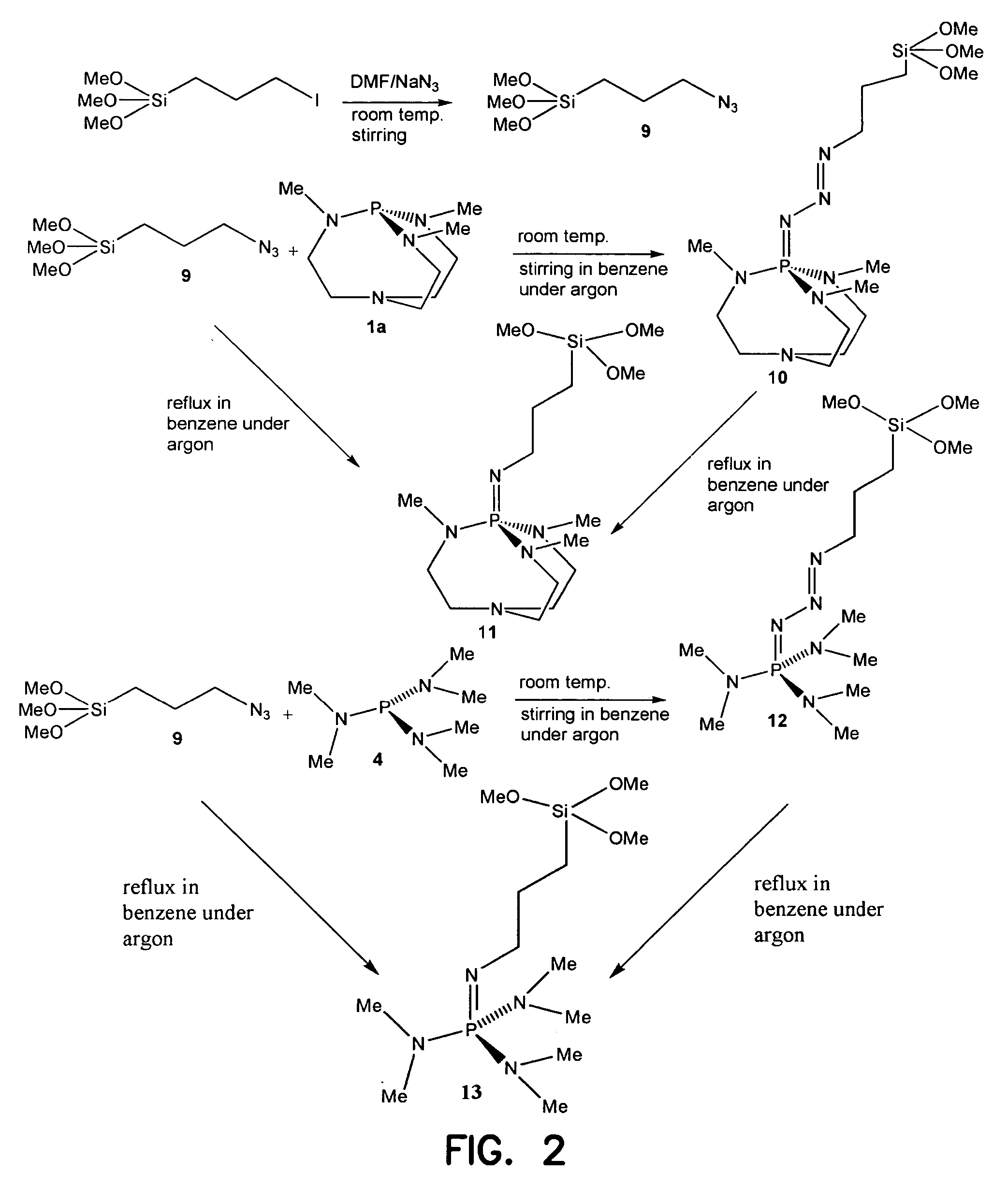Immobilized iminophosphatranes useful for transesterification
- Summary
- Abstract
- Description
- Claims
- Application Information
AI Technical Summary
Benefits of technology
Problems solved by technology
Method used
Image
Examples
example 1
[0037] Preparation of 1-azidopropyl trimethoxy silane (9): 1-Iodo propyl trimethoxy silane (2.90 g, 10.0 mmol) was added to a heterogeneous solution of NaN3 (1.48 g, 20.0 mmol) in DMF (10 mL) under argon in a Schlenk flask. The mixture was stirred for 12 h at room temperature. Dry pentane was added to the reaction mixture which was allowed to stir for 3 h and then permitted to settle. The upper pentane layer was carefully cannulated to another Schenk flask under argon. Removal of pentane under vacuum gave (1.85 g) of 1-azidopropyl trimethoxy silane (90% yield). 1H NMR (400 MHz, CDCl3): δ 0.64 (t, 2H, SiCH2), 1.66 (m, 2H, CCH2C), 3.22 (t, 2H, CH2N3), 3.53 (s, 9H, OCH3). 13C NMR (100.5 MHz, CDCl3): δ 6.44 (SiCH2), 22.57 (CCH2C), 50.65 (OCH3), 53.83(CH2N3).
example 2
[0038] Preparation of azidophosphine (10): To a solution of compound 2 (0.432 g, 2.00 mmol) in dry benzene (15 mL) in a Schlenk flask under argon was added 1-azidopropyl trimethoxy silane (0.410 g, 2.00 mmol) by syringe. The reaction mixture was allowed to stir for 8 h at room temperature. Then removal of benzene under reduced pressure gave of compound 10 in quantitative yield.
example 3
[0039] Preparation of iminophosphorane (11): To a solution of compound 2 (0.432 g, 2.00 mmol) in dry benzene (15 mL) in a Schlenk flask under argon was added 1-azidopropyl trimethoxy silane 9 (0.410 g, 2.00 mmol) by syringe. The reaction mixture was then refluxed under argon for 12 h. After removal of benzene under reduced pressure, 11 was obtained in quantitative yield. 1H NMR (300 MHz, C6D6): δ 1.04 (m, 2H, CH2Si), 2.02 (m, 2H, CCH2C), 2.35 (m, 2H, CCH2), 2.44 (m, 2H, CCH2), 2.58 (dd, 9H, CH3), 3.36 (m, 2H, NCH2), 3.50 (s, 9H, OCH3). 31P NMR (C6D6): δ 19.29.
[0040] Compound (13). 1H NMR (300 MHz, C6D6): δ 1.05 (m, 2H, CH2Si), 1.98 (m, 2H, CCH2C), 2.45 (dd, 18H, CH3), 3.30 (m, 2H, NCH2), 3.50 (s, 9H, OCH3). −P NMR (C6D6): δ 25.41.
PUM
 Login to View More
Login to View More Abstract
Description
Claims
Application Information
 Login to View More
Login to View More - R&D
- Intellectual Property
- Life Sciences
- Materials
- Tech Scout
- Unparalleled Data Quality
- Higher Quality Content
- 60% Fewer Hallucinations
Browse by: Latest US Patents, China's latest patents, Technical Efficacy Thesaurus, Application Domain, Technology Topic, Popular Technical Reports.
© 2025 PatSnap. All rights reserved.Legal|Privacy policy|Modern Slavery Act Transparency Statement|Sitemap|About US| Contact US: help@patsnap.com



